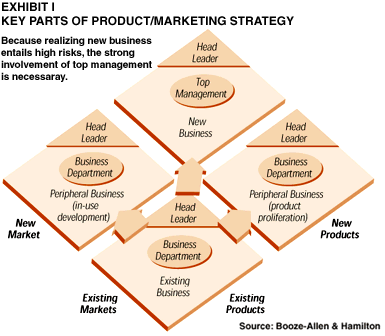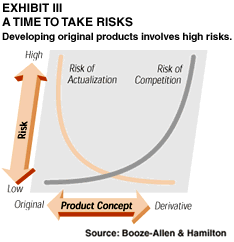Steering a New Course for Japanese Management
If Japan is to be a front-runner in the era of innovation it must demonstrate leadership in developing new industries and products. To do so requires managers to adopt a new "hands-on" approach and to take greater risks.
(originally published by Booz & Company)The age in which Japanese companies were relegated to playing catch-up with European and American firms is over. For some time, the Japanese have been showing their true colors as front-runners in their respective industries. Now, however, they are facing a new task: they must demonstrate leadership in developing new industries and new products.
In the catch-up era, the name of the game was to take existing foreign products, to make them better and cheaper and to sell them in large quantities. In other words, it was an era of slavishly following the market, responding to consumer demands and fulfilling consumer needs. Corporate strategy was delivery-oriented, emphasizing production, sales and distribution.
But in the new front-runner era, there are no more product models to which to refer. Japanese companies must learn how to create potentially valuable products that their competitors haven't thought of. This is a 180-degree turn from the previous era.
In the new era, companies must create new markets and discover new consumer needs; they must shift their emphasis from producing the goods that people want to developing the goods that people are not yet aware they need. The era of delivery has become the era of innovation. This transformation of basic business strategy will be impossible without strong leadership from top management.
In the developed economies of Japan, Europe and North America, the basic needs of the market have almost all been satisfied. In Japan, for example, consumer demand has become dormant as the market has become saturated with products. In a recent survey conducted by the Nikkei Industry Research Center of 2,000 consumers in Tokyo and Osaka, 65.5 percent responded that they were interested in buying new and popular products, but 50.8 percent said that at the present time there was no particular item that they wanted to purchase.
Reacting to these figures, Keiji Toyoda, president of Renown, a large clothing manufacturer and retailer, states:
"The results of this survey are quite alarming. It would be a mistake to think that consumers are holding back because we happen to be in a recession now. I think that consumers have developed a new set of values and a different sense of how they want to live their lives. If we manufacturers don't come up with products that are more in keeping with this new lifestyle, even when the economy recovers, consumers will abandon our products."
In other words, not only must companies undergo a transformation from a delivery-oriented approach to a strategy of innovation, but the hurdle that lies ahead for them is parlaying the "invisible" needs of consumers-- the ones that consumers themselves are not even aware of --into concrete goods and services. To put it another way, as new products appear on the market, consumers will become conscious of their needs and demand will be created.
In the present economic climate, it is simply no longer good enough to use conventional market survey methods to understand consumer needs. As Fumikatsu Tokiwa, president of the Kao Corporation, a large manufacturer and marketer of consumer goods, points out, with good reason, "You don't look to the market to find out what people's needs are; you create needs."
Not only Kao, but also companies like Sharp, Canon, Fuji Photo, Toray, Takara Brewing and Secom are giving birth to products that, as Atsushi Asada, senior vice president of the Sharp Corporation, puts it, "Make the consumer realize with astonishment, 'I've never seen anything like this before!' " Even during Japan's long recession following the collapse of the bubble economy, these companies have avoided losing profits or, at the very least, have kept the decrease much smaller than their competitors have, by creating new demand.
For example, despite a price tag of several thousand dollars, sales of Sharp's Liquid Crystal ViewCam have been so brisk that production has not been able to keep up with demand. Since 1994, Sharp, though only one-quarter the size of Matsushita Electric, has recorded operating profits of roughly the same size as the larger company. Similarly, the Fuji Photo Film Company's Quick Snap disposable camera has shown continued growth since it was first put on the market in 1986, and it even took 10 full years before excessive competition forced the company to drop its price.
That such products appear from time to time is not a matter of luck, but rather due to the fact that some companies possess the right capabilities. These capabilities, without exception, are what produce industry leaders, or front-runners.
The fundamental challenge for managers from now on will be to build the capabilities to become front-runners, which essentially means perceiving the dormant needs of the market and developing new products before the competition does.
WHY IT'S HARD TO SHED A CATCH-UP MENTALITY
Despite this critical need to change, many Japanese business managers are finding it difficult to rid themselves of their catch-up mentality.
Until now, they have been trying to rally their troops to the battle cry of "Challenge and create!" But Japanese managers are studious types who read books and listen to lectures. While they may speak very eloquently, their words are lacking in substance.
For example, listen to this top manager: "From now on, our products must be backed up by cutting-edge technology. They must be multi-functional, more user-friendly and able to offer a vital service to the consumer." Is it likely that his employees would be moved to take innovative action?
The words sound very good, but to be perfectly blunt, this message is nothing more than fine talk. Another top manager says, "We have to make products using innovative technology that other companies can't imitate," but before the words are even out of his mouth, he adds, "It's very important to make our products distinctive through design and modeling."
In the catch-up era, it's safe to say that there was nothing that could be called an original Japanese product concept. However, the essence of corporate strategy for leading companies is the creation of such concepts.
For this reason, Kao established its Basic Research Center, whose sole purpose is to think up product concepts. "Research is where knowledge comes from," says Kaoru Tsujii, the head of the center. "Basic research is where new concepts come from."
Sharp also has what might be termed a concept-design center,
dubbed the Lifestyle Software Planning Headquarters.
Role of developing new technology. According to Prof. Fumio Kodama of the Tokyo Institute of Technology, "The age of technological breakthroughs is over; what we are in now is the age of 'technology fusion.' " To come up with epoch-making products, one must give substance to product concepts. When that happens, companies will not continue to worship technology, but instead will become concept-oriented, by combining existing technologies and developing available but incomplete technologies. Again, as Canon's Mr. Kitamura notes, "Technology development means stepping into the ring with new product concepts and making them a reality."
Kao's Mr. Tsujii adds, "The companies that will survive are those that can articulate a new product concept and incorporate the technology necessary to realize that concept."
John Mayo, former president of AT&T/Bell Labs, which turned out seven Nobel Prize winners, stresses the importance of product-actualizing technology: "I think American companies are ahead of Japanese companies in terms of technological innovation. But no matter how marvelous the discovery, if it can't be translated into a product, no one will benefit from it."
Furthermore, technology development performs the function of fighting off the challenge of companies playing catch-up and strengthens the position of top companies. This means developing "key components," essential technology that is not just a pale imitation of the competition's technology. Some examples of this are Sharp's liquid crystal technology and Canon's LBP semiconductor technology as well as technology introduced from copying machines that converts photosensitive cylinders into cartridges.
Adjusting to market needs. The final stage in the new paradigm of product development is adjusting a finished product to the needs of the market. This is a necessary step because, given the dormant nature of market needs, there's no guarantee that a finished product will fit the consumers' demands perfectly.
Products are the medium for communication between corporations and the market. Adjustment is the result of this communication.
In the past, it was very common for companies to conduct market surveys in order to grasp the needs of the market in advance and to make adjustments.
In the case of Quick Snap, Fuji Photo conducted an extensive survey of consumers after the first generation of disposable cameras hit the market. The results showed exactly the opposite of what had been predicted. Namely, although the company had designed the camera with the specific concept of being easy to operate for children and the elderly, by far the largest response to the survey was that the product "takes good pictures." Therefore, Fuji made improvements to the camera so that the second generation would take even better pictures.
In this way, through repeated communication with the market, the value of the product became clearer and clearer, and Fuji was able to increasingly expand its market share.
WITHOUT LEADERSHIP, THE FRONT-RUNNER POSITION WILL REMAIN ELUSIVE
The close involvement of managers, rather than the former hands-off style, is indispensable if a corporation is to create epoch-making products and become a top market player.
In general, product/marketing strategy, as illustrated in Exhibit I, can be divided into existing business strategy, peripheral business strategy (in-use development, product proliferation) and new business strategy. For top corporations, the main focus is new business strategy, which has the highest actual risk.

As shown in Exhibit II, new business strategy can be illustrated as a cycle. Management leaders can quickly move through the cycle by taking small risks.

Paradigm shift leadership. The primary function of top management is to reinforce the process of discovering new ideas by bringing about a shift toward a new paradigm of product development. The core of that shift must be a transformation of organizational and personnel management.
Fundamentally, the strategic variable in the process of discovering new ideas is creativity. To be sure, even top managers cannot directly affect the creativity of individuals or teams. However, at the very least, it is essential that managers establish an environment in which creativity can be optimally expressed.
For example, companies can create mechanisms for discovering new product concepts, like Sharp's Lifestyle Software Planning Headquarters. These would consist of teams of personnel with varying backgrounds in science, the arts and other relevant disciplines. Such mechanisms ought to be flexible enough to allow the free flow of personnel from one team to another.
In addition, managers need to help speed up mechanisms for turning new ideas into actual products that can support viable enterprises. With this goal, Sharp's top management introduced a three-dimensional design system intended to actualize concurrent engineering. As a result, the design and production departments were able to share information about new products without having to create mock-ups, greatly increasing the speed of product development.
In this way, top corporations have moved their strategic variable away from the product quality and cost models of the catch-up era and toward value-creation/speed models. This is because the key to success for top corporations today is the value of their products and the size of their lead in market sales.
Leadership in focusing management resources. The basic condition necessary for raising the chance of success and lowering the risks in developing original products is focusing management resources (especially personnel, information, knowledge and motivation). To do this, senior managers must articulate a clear strategic direction.
Top corporations have devised different ways of articulating strategy. While some companies, like Toray Industries, have done so by defining their domain, others have laid down very concrete parameters, as Fuji Photo did with its hit Quick Snap: a 35-millimeter film cartridge and ISO 400 film for 1,000 yen. Sharp's strategy is more middle-of-the-road: "To open up the possibilities for children in electronics, making use of liquid crystal displays," said a member of the company's top management.
However, it is meaningless to try to put labels on fields such as electronics, biotechnology and space-age materials. The words of one researcher at a food company vividly attest to this: "Biotechnology is too broad a term; I don't feel comfortable with it."
Leadership in promoting development. For a corporation to become a front-runner, managers must do more than simply exercise strategic leadership. They must take one more step forward in displaying that leadership.
The type of leadership style that can be seen at top corporations in America, like the Minnesota Mining and Manufacturing Company or Rubbermaid Inc., is a top-down approach, with a typical objective to raise sales a certain percentage by introducing a new product. Leading Japanese corporations rarely adopt such a style. Instead, the fundamental ideology is one of "invisible leadership," which insists on encouraging ideas to rise from the bottom up.
A classic example of invisible leadership can be seen in the recent management practices of the Toshiba Corporation. To develop products suited to the multimedia age, Toshiba's top management assembles talented personnel from within the company to create what is unofficially called a Panel of Experts. The panel is divided into two groups. Team No. 1 sets down 9 or 10 topics ("domains") related to its members' visions for the 21st century, while Team No. 2 takes these topics and creates product concepts and broad enterprise plans. Toshiba went further and established its ADI (for Advanced Intelligence, Information, Integration) Project Department for developing products and technology.
In short, what drives the Japanese leadership style is the power of employees. The personnel system of Japanese corporations is extremely refined, but too fixed. The involvement of top management is required to effect change.
Sharp, one top corporation that is receiving a lot of attention these days, has become quite famous for its Kinpro product development program, a model of management leadership.
Kinpro is short for Kinkyu Proj-ect, or Emergency Project. It is under the direct control of the company president and answers to neither the research center nor any of the business departments; its expenses are paid by the head office. Proposals submitted by each department are carefully considered by a General Technology Council (composed of managers and non-management personnel). Those that are approved are forwarded to Kinpro for action. Members of this team are permitted to wear the gold badges that are normally reserved for company executives and are given preference in the use of company facilities and in procuring materials. However, the Technology Council keeps a very close watch over their activities.
The success rate of products handled by Kinpro, such as the Liquid Crystal ViewCam and the Electronic Systems Notebook, is astonishingly high. This is no doubt due to the fact that the company's energies and resources, under the leadership of top management, are focused on this one project. Furthermore, the close involvement of top management has heightened the motivation levels of product designers, and the special treatment that these select employees receive has given them a sense of pride.
This project demonstrates the importance of "visible leadership," which encourages the give and take of ideas and facilitates the realization of product concepts.
Engendering a culture of front-runners. The last directive for top management is to foster a corporate culture favorable for creating front-runners. Although the various corporate policies discussed so far do implicitly engender such a culture, managers must also clearly and directly articulate their operating principles.
Companies that have successfully developed original and epoch-making products have one thing in common. That is, a good-natured culture of competitiveness that sends the following messages to employees: "We must make something no one has ever seen before" and "Second-best isn't good enough."
Top managements play a large role in helping employees to internalize these values. To mark Fuji Photo's 50th anniversary in 1984, Minoru Onishi, then the president and now the chairman, proclaimed the company's "Second Founding" by articulating the principle of I&I (Imaging and Information). He called on his employees to "return to basics" and "create innovative products."
The bible at Canon is a document, entitled "Research and Development Principles," that enshrines the following ideals: "Create a field of technology and a line of products that the world has never seen" and "Respect the competition's technology and products" (i.e., do not simply imitate others).
In Sharp's case, the founder, Tokuji Haya-kawa, imbued his company with a sense of "sincerity and ingenuity." According to Mr. Asada, the senior vice president, "The role of top management is faithfully to pass on the founder's ingenuity with adjustments for the demands of the times." Sharp is now in its third generation of company presidents; each president has passed on the spirit of its founder to the next.
Together, Japan's corporations, by making such ideals the backbone of their management policies, will engender a culture of front-runners.
TOP MANAGEMENT MUST TAKE HIGH RISKS
For the top management of Japan, who hold the future in their hands, an essential part of becoming a front-runner is designing epoch-making new products, not to mention developing new businesses.
 However, as shown in Exhibit III, it is now necessary to take high risks to create original products, which was not the case in the catch-up era, when companies could compete
However, as shown in Exhibit III, it is now necessary to take high risks to create original products, which was not the case in the catch-up era, when companies could compete
sufficiently even with similar products. Therefore, if top managers do not get closely involved and display bold leadership, success will remain elusive.
The ways in which top management should display leadership can be summarized in the following three points:
1) Promote a new paradigm of product development strategy. The key to this is strengthening the process of discovering new ideas and new product concepts while speeding up the process of product development. In short, management needs to convert to a new strategy that emphasizes product value and speed, rather than quality and cost.
2) Focus company resources and reduce actual risks by clearly articulating strategic direction.
3) Vigorously push forward the process of creating epoch-making products. This includes the following two elements:
![]() Creation of an environment (organizations, systems, corporate culture) that is hospitable to helping new ideas emerge.
Creation of an environment (organizations, systems, corporate culture) that is hospitable to helping new ideas emerge.
![]() Direct intervention of management in the give and take, evaluation and realization of new ideas.
Direct intervention of management in the give and take, evaluation and realization of new ideas.
These points are what define the management leadership style that is being implemented with good results at all top corporations. They are the conditions necessary for new managers to lead their companies to success in the 21st century. ![]()
Reprint No. 97205




